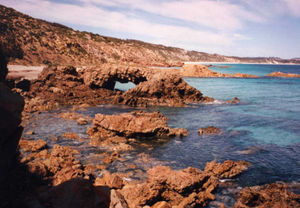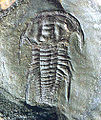Emu Bay Slate
The Emu Bay Shale is a lithostratigraphic formation in South Australia that was deposited in Lower Cambrian about 525 million years ago BP . It includes an important conservation deposit (fossil finds with soft-body preservation), which contain trilobites from the order of the Redlichiida .
The Emu-Bay slate corresponds roughly to the Burgess slate , but it has a larger grain size and therefore a somewhat poorer conservation potential overall.
description
The Emu Bay slate was named after its type locality , Emu Bay. This is on the north side of Kangaroo Island east of Cape d'Estaing , coordinates: 35 ° 35 ′ 0 ″ S , 137 ° 30 ′ 0 ″ E in South Australia. The Emu Bay Shale is Australia's only conserved deposit of the Burgess Shale type .
Stratigraphy and geological framework
The Emu Bay Shale belongs to the 3500 meter thick upper section of the Kangaroo Island Group , which was deposited in a sedimentation basin, the Stansbury Basin , formed by active lateral shifts . The Stansbury Basin was only part of a much larger depression area, the so-called Adelaide Geosyncline , the sediment content of which was shifted towards the Gawler Craton during the Delameric orogeny . The Emu Bay Shale can reach up to 150 meters in thickness and lies either concordantly or discordantly above the White Point Conglomerate . It is overlaid by the boxing bay formation .
Lithology
The majority of the Burgess schist-type conserved deposits were deposited in the deep water of the outer shelf area. The Emu Bay shale, on the other hand, is a purple-colored shale and appears to have been deposited under shallow water conditions ( lagunary facies). This leads to the conclusion that soft body conservation took place in different areas of the facies during the Cambrian. Some fossil finds from the Emu Bay shale show an intensive mineralization of the soft body tissue, mostly through granular apatite or fibrous calcite . Even phosphatized muscle tissue was detected - so far the oldest find of this kind in the Cambrian. Mineralized soft body tissues are actually rare in the Burgess slate type faunal communities.
There are numerous traces and prints of trilobites in the slate. At its base above the White Point conglomerate, the Emu Bay schist has sandy limestone and a limestone layer with traces of digging. Together with the White Point Conglomerate, it can be correlated with the Oraparinna schist .
Occurrence
There are two significant occurrences of Emu Bay shale:
- the profile of the type locality on the east side of Emu Bay. It lies concordantly on the White Point conglomerate and contains a rich fauna composed of Balcoracania , Redlichia , hyolithids , brachiopods and the sclerite-leading Chancelloria .
- the Big Gully location 8 kilometers to the east. The Emu Bay shale lies here discordantly above the White Point conglomerate. In addition to the trilobites, fossils occur in soft-body conservation, e.g. B. the predatory Anomalocaris , Isoxys , Tuzoia , Paleoscolex (probably a string worm ), Myoscolex (problematic classification) and several rarer finds. The soft body tissue of the trilobites was predominantly mineralized. A few Redlichia finds have antennas.
fauna
The fauna of the Emu Bay slate generally has a very high number of individuals compared to other sites of the Burgess slate type, but has only a very limited biodiversity. Consistent with other localities, the Emu Bay slate community includes species such as Anomalocaris , Tuzoia , Isoxys , Xandarella, and Primicaris ; these species can also be found in the Chinese Chengjiang faunal community - relatively close palaeogeographically at the time, but of a later age.
Also of great importance are beautiful finds of trilobites such as B. Redlichia takooensis , Emuella polymera , Balcoracania dailyi and Estaingia bilobata . The genera Balcoracania and Emuella belong to the superfamily Emuelloidea within the Redlichiina , which are known for a very high number of segments (over 60 in large Balcoracania finds) and also only occur in Australia.
List of fauna sorted by tribes
Phylum Porifera (sponges)
Tribe Lobopodia (Lobopods)
Phylum Arthropoda (arthropod)
- Anomalocaris briggsi
- Anomalocaris sp.
- Isoxys communis
- Myoscolex ateles
- Tuzoia australis
- Xandarella spectaculum
Phylum Arthropoda - class Trilobita
- Balcoracania dailyi - order Redlichiida
- Emuella dalgarnoi - order Redlichiida
- Emuella polymera - order Redlichiida
- Estaingia bilobata - order Ptychopariida
- Redlichia sp. - Order Redlichiida
- Redlichia takooensis - order Redlichiida
Strain Nematomorpha (hairworm)
Photo gallery
See also
- Fossil deposit - other deposits
- List of important fossil sites
Individual evidence
- ^ Glaessner, MF: Lower Cambrian Crustacea and annelid worms from Kangaroo Island . In: Alcheringa: An Australasian Journal of Palaeontology . tape 3 , no. 1 . Taylor & Francis, 1979, pp. 21–31 , doi : 10.1080 / 03115517908565437 ( informaworld.com [PDF]).
swell
Note: Much of the post is based on his website, particularly the Emu Bay page , with the permission of Sam Gon III
About Australian trilobites:
- Hagadorn, JW (2002). "Burgess Shale-type Localities: The global picture". In Bottjer, DJ, W. Etter, JW Hagadorn & CM Tang, eds. Exceptional Fossil Preservation - A Unique View on the Evolution of Marine Life. Columbia University Press. ISBN 0-231-10254-2 .
- Greg Edgecombe and the Australian Museum. "Australian Trilobites: A Species List and Bibliography" Found on August 23, 2005.
- Sam Gon III. "A guide to the Orders of Trilobites" Found on August 23, 2005.
- Nedin, C. (1995). "The Emu Bay Shale, a Lower Cambrian fossil deposit, Kangaroo Island, South Australia". Memoirs of the Association of Australasian Palaeontologists 18: 31-40.
- Simpson, Dave. "Trilobites of South Australia" Found on August 23, 2005.




